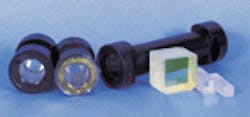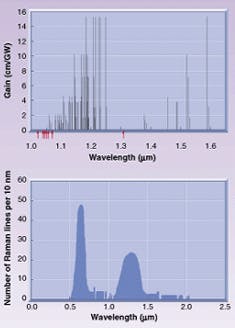NONLINEAR OPTICS: Stimulated Raman scattering augments DPSS lasers
Nonlinear optics based on stimulated Raman scattering produce hundreds of wavelengths from diode-pumped solid-state lasers and can compress their pulses.
Guerman A. Pasmanik
The use of nonlinear optical effects for control of laser output parameters is becoming more widespread. The production of such effects can be based on a laser's average optical power output or on the peak power of its pulses. Nonlinear effects that depend upon average power include thermal effects, effects of wave interaction in photorefractive crystals, and others. Nonlinear effects that depend upon the peak power of laser pulses are more varied in origin. Diode-pumped solid-state lasers with high repetition rate (>=1 kHz), high peak power (>=1 MW), and short pulse durations (10-9-10-13 s) are well suited for producing these nonlinear effects.
FIGURE 1. Materials used for wavelength conversion via stimulated Raman scattering include liquids (top left, in liquid cells) and crystals (top right). Parameters of such materials exhibit a variety of magnitudes at 1064 nm (bottom).
Shorter rods, shorter pulses
Stimulated Brillouin scattering (SBS), forward or backward Raman scattering, and harmonic generation can all be produced by pulsed lasers. They are best produced when the transverse structure of the beam is close to fundamental (TEM00) mode and when pulses have durations of a few nanoseconds or less. Such pulses can be obtained in a resonator of a few centimeters in length or shorter. In such a resonator, the TEM00 mode can be excited if the beam diameter is less than 1 mm. However, the maximal intensity of these short pulses and minimal pulse durations are limited by self-focusing, another nonlinear effect.
In longer laser rods of 5-8 cm, self-focusing limits the peak intensity of pulses to the 1-2 GW/cm2 level. In shorter rods of 5-8 mm, it is possible to reach the maximum intensity of 10-20 GW/cm2. At the same time, the energy density of the output pulses is either comparable to or only two to three times greater than the density of the saturation energy. To obtain pulse energies of a few millijoules in a 1-mm-diameter laser beam exiting from a 5-8-mm rod, the pulse duration must be longer than 100-150 ps, or else the self-focusing will destroy the rod.
Currently, the highest conversion efficiency of diode-pumped solid-state laser radiation into the TEM00 mode is obtained by end-pumping the laser crystal; however, the length of the pump area inside the laser crystal where diode radiation is absorbed is a few millimeters or less. Under these conditions, the pump beam diameter cannot be large due to excitation of parasitic radiation in the transverse direction. For these reasons, it is impossible to extract high energy from a laser pulse by end-pumping. In a laser amplifier with a pump area several millimeters in diameter, the maximum energy extracted will not exceed 50-100 mJ; therefore, an end-diode-pumped laser designed for pulse energy of 1 J or more and having TEM00 output must be multichannel (using more than one laser rod). Modelocking of several channels can be provided by a SBS phase-conjugation mirror.
Stimulated Brillouin scattering
Limitations are typical for nonlinear media. Due to the increase of self-focusing instabilities in the presence of shorter laser pulses, it is necessary to select nonlinear media in which typical gains responsible for Brillouin, Raman, or parametric interactions will exceed the gain corresponding to self-focusing. While self-focusing in solid-state materials occurs without a time lag, the other relevant nonlinear processes do lag in time, with the result that the efficiency of these processes decreases with the shortening of the pulses, at least in the picosecond range.
For example, SBS at 1064 nm has a significantly higher gain than self-focusing only if pulse durations are greater than 1 ns. In practice, this means that SBS can be used, for example, for compression of 2-3-ns pulses to pulsewidths of 200 ps. However, in order to avoid thermal effects, the user has to focus the laser beam into liquids with very low optical absorption (<=10-6 cm-1). These liquids have to be devoid of submicron particles in order to avoid their heating in the presence of the focused laser beam. It is also necessary to select liquids stable against any chemical reactions accompanying possible heating of microparticles in the field of the focused laser beam.
Frequency conversion allows the production of ultraviolet (UV) radiation of a chosen wavelength from infrared (IR) radiation. Frequency conversion is accomplished in practice either by stimulated Raman scattering (SRS) or by three-wave parametrical interaction. For three-wave interaction, the level of pump power is relatively low and is convenient for the conversion of solid-state laser radiation having a high repetition rate. An optical parametrical oscillator (OPO) is excited efficiently for pump pulsewidths of several nanoseconds. For significantly shorter pulses, it is more convenient to use optical parametrical amplification starting from spontaneous parametrical noises. The most efficient conversion can be achieved in a multipass scheme, which increases the length of the beam interaction.
In three-wave processes, however, pulse compression does not occur. The transverse structure of radiation in an OPO usually does not correspond to the TEM00 mode and very often deviates from pulse to pulse. Moreover, OPO jitter is close to the round-trip propagation time through the OPO cavity (0.5-1 ns). The frequency bandwidth as a rule is >=1 cm-1. All these considerations make it difficult to form pulses suitable for further conversion in second, third, and higher-order harmonic generators.
It is possible to avoid these problems using backward SRS, which provides some additional benefits. Stimulated Raman scattering allows the cleanup of laser beams and compression of subnanosecond pulses to tens of picoseconds. Jitter can be very small and, for the focused laser beams, dependent only on propagation time through the focal waist area.
SRS inside and outside of the resonator
For frequency conversion and compression of pulses shorter than 0.1-1 ns, the most-suitable process is SRS. Generally, SRS occurs in both the forward and the backward directions and competes with self-focusing. This effect is being studied by different groups, mainly with the goal of frequency conversion.1-3 The simplest scheme of Raman conversion can be realized in conditions where a nonlinear medium is placed inside a laser resonator having a high-reflectivity mirror for the pump wavelength but a semitransparent mirror for the Raman-shifted wavelength.
The quantum efficiency of such a Raman laser can be greater than 80%-90%. However, the duration of the Raman-shifted pulse is close to the duration of the laser pulse. In the Raman laser, exceeding the SRS threshold occurs very sharply; usually there is no possibility for generation of one longitudinal mode without auxiliary selectors such as a Fabry-Perot etalon, diffraction grating, or other methods.
If the Raman medium is located outside of the resonator, extraction of the backward Raman-shifted pulse can be achieved with the help of a retardation plate. This plate rotates polarization for the laser beam or the Raman-shifted beam but not for both.
SRS pulse compression
Backward SRS can be used for pulse compression. To achieve this, the TEM00 laser beam should be focused into Raman materials such as crystals or liquids. The length of such a crystal or liquid cell must exceed the spatial length of the laser pulse.
If the peak power of the focused pump beam exceeds several hundred kilowatts, both forward and backward SRS are excited. The direction of SRS depends on the ratio of the laser beam diameter to the focal distance. If this ratio is large enough, backward SRS dominates over forward SRS, which is suppressed due to Stokes-anti-Stokes interaction. Focusing conditions should be adjusted to avoid damage at the surface and inside the bulk of the Raman crystal. As a rule, the bulk damage threshold is a few times greater than the surface damage threshold.
Tests of Raman crystals at Passat Ltd. have shown that, after exceeding the backward SRS threshold, the intensity of the laser pulse penetrating into the focal waist area remains close to the threshold intensity. Therefore, the negative influence of self-focusing is not significant even if laser pulse power exceeds the threshold; however, the critical power of self-focusing in a Raman material should be two to three times greater than the SRS threshold power. The same is true for bulk damage and for double-photon absorptionat least for the near-IR range. For the same reason, the thermal effects accompanying SRS in the field of a focused laser beam having a high repetition rate do not rise dramatically with increase of the pump power. In particular, a stable backward Stokes output in Ba(NO3)2 has been observed at a 1-kHz repetition rate and exceeding the SRS threshold by tenfold.
New wavelengths
Conversion of wavelengths via SRS allows a very wide range to be covered. Consider the use of the following crystals as master oscillators: Yb:YAG (ytterbium:YAG; emits at 1029 nm), Nd:YLF (Nd:yttrium lithium fluoride; 1047 and 1053 nm), Nd:YAG (1061, 1064, and 1319 nm), Nd:YAP (Nd:yttrium aluminum perovskite; 1079 nm). These wavelengths can be used to excite SRS in a variety of Raman materials (see Fig. 1). The result can be a wide set of Raman-shifted wavelengths in the 1.1-1.6-µm range. By adding Stokes components excited in crystals with significant Raman shift such as diamond or lithium formate, or in the liquids SiCl4, SnCl4, and GeCl4, nearly 100 Raman lines corresponding to each of the aforementioned pumps can be obtained. Repeating the SRS excitation process results in hundreds of new additional lines (see Fig. 2).
FIGURE 2. The 1029-1079-nm emission lines of Nd:YAG and other similar solid-state lasers excite stimulated Raman scattering (SRS) in various Raman crystals to produce wavelengths in the 1.1-1.6-µm range. Any of 91 Raman lines can be obtained (top; small arrows on x axis indicate laser wavelengths). Repeating the process of SRS results in the availability of 637 lines in the 1-2-µm range (bottom). Second-harmonic generation results in an equal number of lines available in the 0.5-1-µm range.
Obtaining coherent light with frequencies corresponding to a double Raman shift is reasonable if the efficiency of each step remains high (>50%-60%). Research at Passat shows that, with optimal geometry, such high coefficients of conversion are quite attainable. Taking into account that a SRS converter is a relatively simple device, the conclusion is that SRS can seriously compete with an OPO in obtaining a wide range of frequencies. Some expansion of the range of frequencies can be achieved also by shifting the frequency of the fundamental wavelengthfor example, using a tunable Fabry-Perot etalon placed inside the resonator.
Generation of short pulses in the near-IR via SRS allows achieving their effective conversion into the UV range by sum-frequency generation (SFG). The efficiency of SFG depends upon peak pulse power and upon the transverse structure of the beam. A pulse with TEM00 mode and at least several hundreds of megawatts of peak power is sufficient for highly efficient conversion not only to second but also to higher (up to fifth or sixth) harmonics. Moreover, conversion efficiency can also be increased by selecting the wavelengths that fulfill conditions for noncritical phase matching.
Formed in this way, sources of short pulses in UV, visible, and IR ranges have a very wide range of applications. These include micromachining, deep-UV lithography, medicine, remote sensing (especially in the eye-safe range), scientific research (for example, excitation of an x-ray plasma via powerful picosecond pulses), and others.
REFERENCES
- J. T. Murray et al., Opt. Lett. 20(9), 1017 (May 1995).
- A. A. Kaminskii et al., Appl. Opt. 38(21), 4533 (July 1999).
- P. G. Zverev et al., Optical Materials 11, 335 (March 1999).
GUERMAN A. PASMANIK is president of Passat Ltd., 401 Magnetic Drive, Unit 43, Toronto, Ontario, Canada M3J 3H9; e-mail: [email protected].



